Themed collection Analytical Nanoscience

Analytical nanoscience
Russ Algar, Tim Albrecht, Karen Faulds and Jun-Jie Zhu introduce the Analyst themed collection on analytical nanoscience.

Analyst, 2022,147, 765-766
https://doi.org/10.1039/D1AN90110A
An overview of therapeutic anticancer drug monitoring based on surface enhanced (resonance) Raman spectroscopy (SE(R)RS)
Recent progress in applying surface-enhanced (resonance) Raman spectroscopy as a novel technique for therapeutic monitoring of anticancer drugs are discussed.
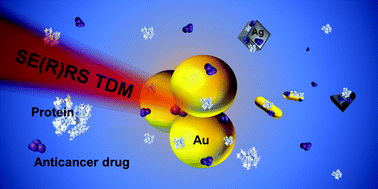
Analyst, 2020,145, 6211-6221
https://doi.org/10.1039/D0AN00891E
Thinking outside the shell: novel sensors designed from plasmon-enhanced fluorescent concentric nanoparticles
This minireview surveys plasmon-enhanced fluorescence in core–shell nanoarchitectures, including examples of applications in multiplex sensing and substrate-based approaches.

Analyst, 2020,145, 5965-5980
https://doi.org/10.1039/D0AN01092H
Engineering at the nano-bio interface: harnessing the protein corona towards nanoparticle design and function
A review of recent literature on rational design, development, and biological applications of engineered nanoparticles with an adsorbed protein corona.
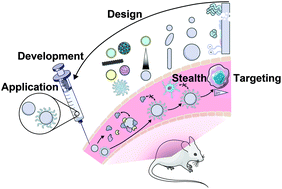
Analyst, 2020,145, 5090-5112
https://doi.org/10.1039/D0AN00633E
Light-responsive nanozymes for biosensing
Using light as an external stimulus plays a key role not only in modulating activities of nanozymes, but also in constructing efficient biosensing systems.
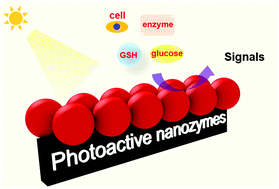
Analyst, 2020,145, 4388-4397
https://doi.org/10.1039/D0AN00389A
Nanomaterial-based multiplex optical sensors
Multiplexed detections based on optical nanomaterials.
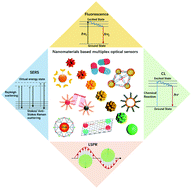
Analyst, 2020,145, 4111-4123
https://doi.org/10.1039/D0AN00392A
Advancements in fractal plasmonics: structures, optical properties, and applications
Fractal nanostructures exhibit optical properties that span the visible to far-infrared and are emerging as exciting structures for plasmon-mediated applications.
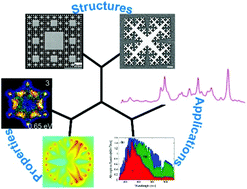
Analyst, 2019,144, 13-30
https://doi.org/10.1039/C8AN01667D
From single cells to complex tissues in applications of surface-enhanced Raman scattering
This tutorial review explores how three of the most common methods for introducing nanoparticles to single cells for surface-enhanced Raman scattering measurements can be adapted for experiments with complex tissues.
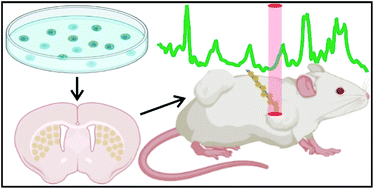
Analyst, 2020,145, 7162-7185
https://doi.org/10.1039/D0AN01274B
Fluorescent organic nanoparticles (FONs) as convenient probes for metal ion detection in aqueous medium
Fluorescent organic nanoparticle (FON)-based chemosensors are emerging as a valuable tool for the fast and accurate detection of metal ions in aqueous media. In this review, we highlight the recent developments in this field.
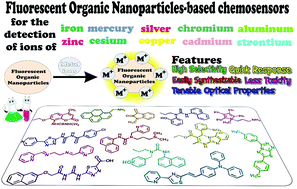
Analyst, 2019,144, 2480-2497
https://doi.org/10.1039/C8AN01801D
Stimuli-responsive polymer/nanomaterial hybrids for sensing applications
Stimuli-responsive polymer (SRP)-based nanoparticles and SRP/nanomaterial hybrids have myriad applications, we review their uses for chemical sensing and biosensing.
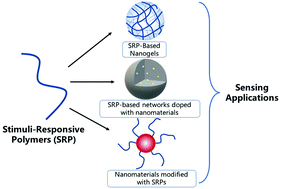
Analyst, 2020,145, 5713-5724
https://doi.org/10.1039/D0AN00686F
Luminescent probes for hypochlorous acid in vitro and in vivo
Recent advances in the detection of HClO/ClO−in vitro and in vivo using fluorescent, phosphorescent and chemiluminescent probes are reviewed.
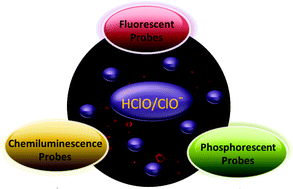
Analyst, 2020,145, 5068-5089
https://doi.org/10.1039/D0AN00645A
Recent advances of plasmonic nanoparticle-based optical analysis in homogeneous solution and at the single-nanoparticle level
Recent advances of plasmonic nanoparticle-based optical detection systems for various analytes in homogeneous solution and at the single-nanoparticle level are summarized.
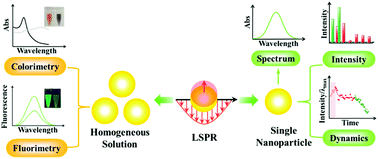
Analyst, 2020,145, 4737-4752
https://doi.org/10.1039/D0AN00609B
Recent advances in nanomaterial-enhanced enzyme-linked immunosorbent assays
This review highlights functional roles of nanomaterials for advancing conventional ELISA assays by serving as substrate-alternatives, enzyme-alternatives, or non-enzyme amplifiers.
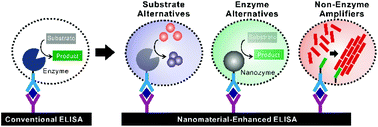
Analyst, 2020,145, 4069-4078
https://doi.org/10.1039/D0AN00597E
Recent advances in nanomaterial-based electrochemical and optical sensing platforms for microRNA assays
This review describes recent efforts in the application of nanomaterials as sensing elements in electrochemical and optical miRNAs assays.

Analyst, 2019,144, 2849-2866
https://doi.org/10.1039/C9AN00081J
Molecular and living cell dynamic assays with optical microscopy imaging techniques
Compared with the conventional ensemble averaged measurements, single object analysis with optical microscopy can obtain the heterogeneous behavior of many individual objects, avoiding false judgment. Moreover, higher spatial and temporal resolution has been achieved by various optical imaging technologies.
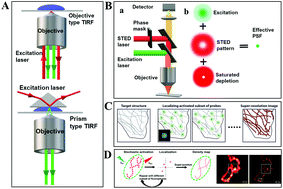
Analyst, 2019,144, 859-871
https://doi.org/10.1039/C8AN01420E
Electrochemiluminescence biosensing based on different modes of switching signals
Electrochemiluminescence (ECL) has attracted much attention in various fields of analysis owing to low background signals, high sensitivity, and excellent controllability.
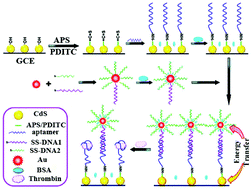
Analyst, 2018,143, 3230-3248
https://doi.org/10.1039/C8AN00276B
Recent advances in nanoparticle-based lateral flow immunoassay as a point-of-care diagnostic tool for infectious agents and diseases
Recent advances in lateral flow immunoassay-based devices as a point-of-care analytical tool for the detection of infectious diseases are reviewed.
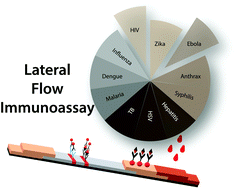
Analyst, 2018,143, 1970-1996
https://doi.org/10.1039/C8AN00307F
Paper-based SERS analysis with smartphones as Raman spectral analyzers
We present a smartphone-based portable Raman spectrometer, which has a friendly human–machine interface, easy operation, rapid response time, and most importantly a very small size for on-site use.
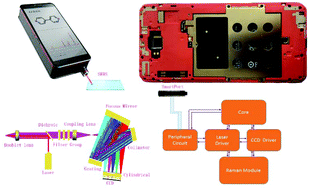
Analyst, 2019,144, 137-142
https://doi.org/10.1039/C8AN01901K
Quantum dot to quantum dot Förster resonance energy transfer: engineering materials for visual color change sensing
Manipulation of quantum dot (QD) properties improves QD–QD energy transfer enabling the concerted design of visual color change-based sensors.
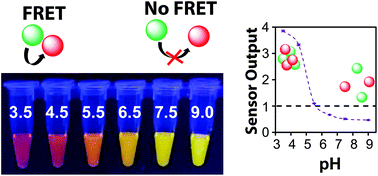
Analyst, 2020,145, 5754-5767
https://doi.org/10.1039/D0AN00746C
Dynamic pH measurements of intracellular pathways using nano-plasmonic assemblies
Functionalized plasmonic Ag nano-assemblies moving in a living cell were employed to visualize the spatiotemporal change of intracellular pH by surface-enhanced Raman scattering.

Analyst, 2020,145, 5768-5775
https://doi.org/10.1039/D0AN00986E
Interactions between gold, thiol and As(III) for colorimetric sensing
Arsenite cannot crosslink glutathione-capped gold nanoparticles but a high concentration of arsenite can displace adsorbed glutathione, indicating that any two species from gold, thiol and arsenite can react.
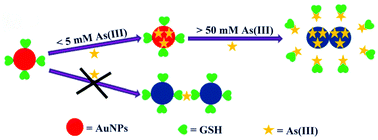
Analyst, 2020,145, 5166-5173
https://doi.org/10.1039/D0AN00946F
Gold nanoparticle-streptavidin conjugates for rapid and efficient screening of aptamer function in lateral flow sensors using novel CD4-binding aptamers identified through Crossover-SELEX
Adaptation of conventional lateral flow tests: demonstration of a lateral flow assay in which gold nanoparticle conjugates, when bound to aptamers, serve as a reporting system to screen novel aptamers for the ability to bind to target proteins.
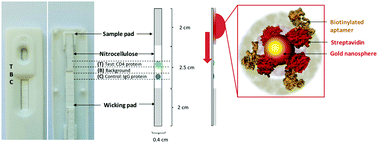
Analyst, 2020,145, 5180-5193
https://doi.org/10.1039/D0AN00634C
Sensitive determination of formamidopyrimidine DNA glucosylase based on phosphate group-modulated multi-enzyme catalysis and fluorescent copper nanoclusters
An approach for the quantification of formamidopyrimidine DNA glucosylase is designed based on phosphate group-modulated multi-enzyme catalysis and fluorescent copper nanoclusters.

Analyst, 2020,145, 5174-5179
https://doi.org/10.1039/D0AN00928H
Synthesis and SERS application of gold and iron oxide functionalized bacterial cellulose nanocrystals (Au@Fe3O4@BCNCs)
Bacterial cellulose nanocrystals (BCNCs) are biocompatible cellulose nanomaterials that can host guest nanoparticles to form hybrid nanocomposites with a wide range of applications.
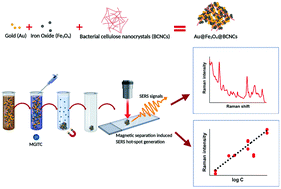
Analyst, 2020,145, 4358-4368
https://doi.org/10.1039/D0AN00711K
A novel liquid biopsy-based approach for highly specific cancer diagnostics: mitigating false responses in assaying patient plasma-derived circulating microRNAs through combined SERS and plasmon-enhanced fluorescence analyses
Novel multimodal assay has been developed to quantify circulating microRNAs through a combined surface-enhanced Raman scattering and plasmon-enhanced fluorescence approach.

Analyst, 2020,145, 4173-4180
https://doi.org/10.1039/D0AN00538J
An enhanced gas sensor based on SiO2@mesoporous MCM-41 core–shell nanocomposites for SO2 visual detection
A colorimetric sulfur dioxide (SO2) gas sensor based on a core–shell composite was developed.
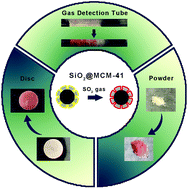
Analyst, 2020,145, 4352-4357
https://doi.org/10.1039/D0AN00621A
In situ amplified photothermal immunoassay for neuron-specific enolase with enhanced sensitivity using Prussian blue nanoparticle-loaded liposomes
Methods based on prussian blue nanoparticles (PBNPs) have been reported for photothermal immunoassays in analytical nanoscience fields but most suffer from low sensitivity and are not beneficial for routine use.
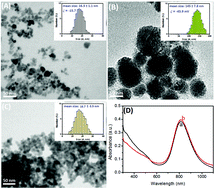
Analyst, 2020,145, 4164-4172
https://doi.org/10.1039/D0AN00417K
An alternative approach for the preparation of a core–shell bimetallic central metal–organic framework as a hydrophilic interaction liquid chromatography stationary phase
A new type of core–shell composite material was prepared and applied as a hydrophilic interaction liquid chromatography (HILIC) stationary phase.
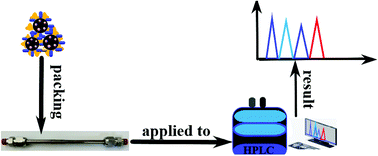
Analyst, 2020,145, 3851-3856
https://doi.org/10.1039/D0AN00304B
Metabolic mapping with plasmonic nanoparticle assemblies
Discrete plasmonic gold nanoparticle assemblies rapidly detect ATP in single cells and microenvironments without labelling, extraction, purification or separation.
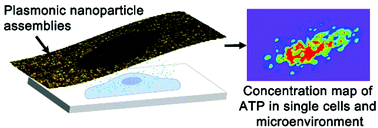
Analyst, 2020,145, 2586-2594
https://doi.org/10.1039/C9AN02262G
Rapid quantification of prion proteins using resistive pulse sensing
Prion diseases are a group of fatal transmissible neurological conditions caused by the change in conformation of intrinsic cellular prion protein (PrPC).
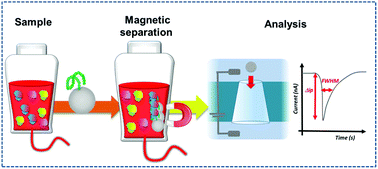
Analyst, 2020,145, 2595-2601
https://doi.org/10.1039/D0AN00063A
Er3+-to-dye energy transfer in DNA-coated core and core/shell/shell upconverting nanoparticles with 980 nm and 808 nm excitation of Yb3+ and Nd3+
FRET from upconversion nanoparticles to dyes using 980 nm and 808 nm excitation.
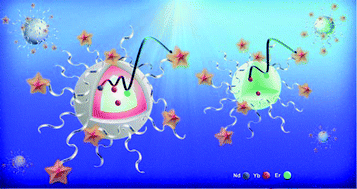
Analyst, 2020,145, 2543-2553
https://doi.org/10.1039/C9AN02532D
Spectroelectrochemical and computational studies of tetrahydrocannabinol (THC) and carboxy-tetrahydrocannabinol (THC-COOH)
Electrochemical SERS allows for the rapid detection of both THC and THC-COOH in bodily fluid matrices without interferences from matrix species, paving the way to a point-of-need tool for cannabinoid detection.
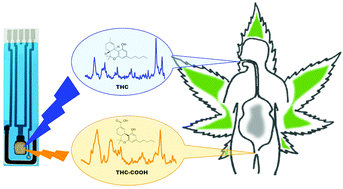
Analyst, 2020,145, 1849-1857
https://doi.org/10.1039/C9AN02173F
Gold nanostars as a colloidal substrate for in-solution SERS measurements using a handheld Raman spectrometer
Colloidal gold nanostars for rapid and in-solution SERS measurements of methimazole in urine using a handheld Raman spectrometer.
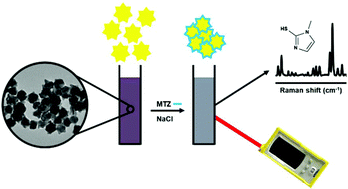
Analyst, 2020,145, 1396-1407
https://doi.org/10.1039/C9AN02439E
Rapid differentiation of Campylobacter jejuni cell wall mutants using Raman spectroscopy, SERS and mass spectrometry combined with chemometrics
SERS was developed for intercellular and intracellular analyses. Using a series of cell wall mutants in C. jejuni we show cell wall versus cytoplasm differences.
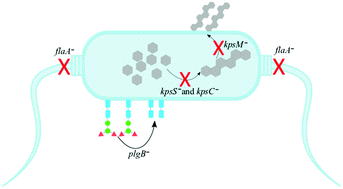
Analyst, 2020,145, 1236-1249
https://doi.org/10.1039/C9AN02026H
Detection of cardiovascular disease associated miR-29a using paper-based microfluidics and surface enhanced Raman scattering
A paper-based microfluidics self-testing device capable of colorimetric and SERS-based sensing of cardiovascular disease associated miR-29a has been developed for improving patient care and triage.
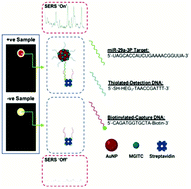
Analyst, 2020,145, 983-991
https://doi.org/10.1039/C9AN01748H
Rapid detection of Shiga toxin type II using lateral flow immunochromatography test strips of colorimetry and fluorimetry
Two types of lateral flow immunochromatographic test strips (LFITS) using gold nanoparticles and fluorescent CdTe quantum dots (QDs) as signal labels, respectively, were developed for Shiga toxin type II (STX2) assays.

Analyst, 2020,145, 76-82
https://doi.org/10.1039/C9AN01996K
Rapid detection of synthetic cannabinoids in herbal highs using surface-enhanced Raman scattering produced by gold nanoparticle co-aggregation in a wet system
SERS with gold nanoparticle aggregates detects synthetic drugs of abuse contained in herbal highs.
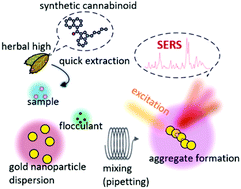
Analyst, 2019,144, 6928-6935
https://doi.org/10.1039/C9AN01512D
Gold nanoparticle amplification strategies for multiplex SPRi-based immunosensing of human pancreatic islet hormones
In this work, we demonstrate the potential use of SPRi for secretion-monitoring of pancreatic islets, small micro-organs that regulate glucose homeostasis in the body.
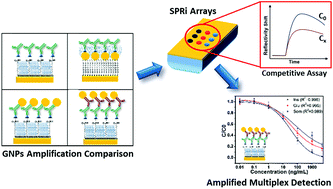
Analyst, 2019,144, 2541-2549
https://doi.org/10.1039/C9AN00140A
Ratiometric fluorescent nanosensors for ultra-sensitive detection of mercury ions based on AuNCs/MOFs
Ratiometric fluorescent nanosensors were developed to detect mercury ions (Hg2+) using enhanced dual emissions from glutathione stabilized gold nanoclusters/indium-based metal–organic frameworks modified with cysteine (AuNCs/MIL-68(In)-NH2/Cys).
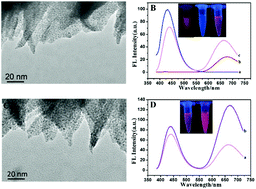
Analyst, 2019,144, 2523-2530
https://doi.org/10.1039/C8AN02414F
Ultrasound combined with manganese-oxide nanoparticles loaded on activated carbon for extraction and pre-concentration of thymol and carvacrol in methanolic extracts of Thymus daenensis, Salvia officinalis, Stachys pilifera, Satureja khuzistanica, and mentha, and water samples
A dispersive micro solid-phase extraction (DMSPE) technique was developed using manganese-oxide nanoparticles loaded on activated carbon (Mn3O4-NPs-AC) as an effective sorbent combined with ultrasound for the extraction and determination of a trace amount of thymol and carvacrol in methanolic extracts of Thymus daenensis, Salvia officinalis, Stachys pilifera, Satureja khuzistanica and mentha, and water samples.

Analyst, 2019,144, 1923-1934
https://doi.org/10.1039/C8AN02338G
Highly hydrophilic polyhedral oligomeric silsesquioxane (POSS)-containing aptamer-modified affinity hybrid monolith for efficient on-column discrimination with low nonspecific adsorption
A highly hydrophilic aptamer-modified POSS-containing hybrid affinity monolith is presented for efficient on-column discrimination with low non-specific adsorption.
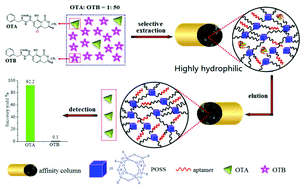
Analyst, 2019,144, 1555-1564
https://doi.org/10.1039/C8AN01890A
Fully inkjet-printed distance-based paper microfluidic devices for colorimetric calcium determination using ion-selective optodes
Fully inkjet-printed and low-cost microfluidic paper-based analytical devices (μPADs) demonstrate the simple naked-eye colorimetric determination of calcium ions in drinking and tap water samples.
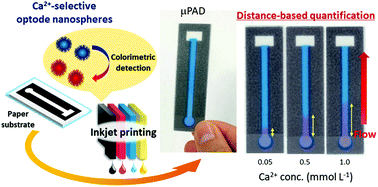
Analyst, 2019,144, 1178-1186
https://doi.org/10.1039/C8AN02146E
Development of a novel wavelength selection method for the trace determination of chlorpyrifos on Au@Ag NPs substrate coupled surface-enhanced Raman spectroscopy
A novel wavelength selection method named ICPA-mRMR coupled SERS was employed for the detection of CPS residues in tea samples.
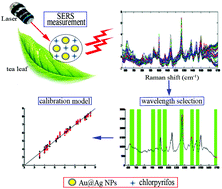
Analyst, 2019,144, 1167-1177
https://doi.org/10.1039/C8AN02086H
Surface-enhanced Raman spectroscopy of microorganisms: limitations and applicability on the single-cell level
Detection and characterization of microorganisms is essential for both clinical diagnostics and environmental studies.
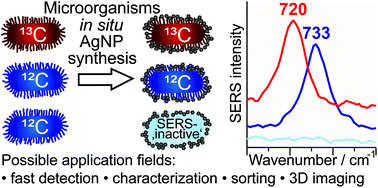
Analyst, 2019,144, 943-953
https://doi.org/10.1039/C8AN02177E
The in vivo effects of silver nanoparticles on terrestrial isopods, Porcellio scaber, depend on a dynamic interplay between shape, size and nanoparticle dissolution properties
The effects of exposure to low concentrations of AgNPs in model tissue, are the result of the interplay between size, shape and dissolution of ions from NPs.
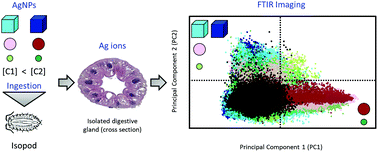
Analyst, 2019,144, 488-497
https://doi.org/10.1039/C8AN01387J
A conjugated carbon-dot–tyrosinase bioprobe for highly selective and sensitive detection of dopamine
A conjugated carbon-dot–tyrosinase bioprobe was first designed and applied for sensitive and selective dopamine detection in human serum.
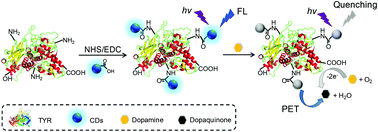
Analyst, 2019,144, 468-473
https://doi.org/10.1039/C8AN01659C
A new photoelectrochemical biosensor for ultrasensitive determination of nucleic acids based on a three-stage cascade signal amplification strategy
Based on a “signal-on” sensing strategy and a three-stage cascade signal amplification method, an ultrasensitive photoelectrochemical biosensor has been developed for DNA detection.
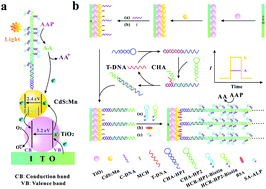
Analyst, 2018,143, 2799-2806
https://doi.org/10.1039/C8AN00609A
Lab on a tip: atomic force microscopy – photothermal infrared spectroscopy of atmospherically relevant organic/inorganic aerosol particles in the nanometer to micrometer size range
AFM-PTIR is utilized to analyze atmospherically relevant multicomponent substrate deposited aerosol particles.
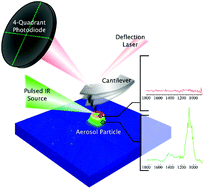
Analyst, 2018,143, 2765-2774
https://doi.org/10.1039/C8AN00171E
Dual functional PDMS sponge SERS substrate for the on-site detection of pesticides both on fruit surfaces and in juice
A versatile dual-functional polydimethylsiloxane (PDMS) sponge Surface Enhanced Raman Scattering (SERS) substrate has been fabricated for the on-site detection of pesticide residues both on the surface and in solution with minimum or no sample pretreatment.
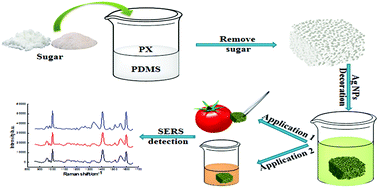
Analyst, 2018,143, 2689-2695
https://doi.org/10.1039/C8AN00476E
Electrochemical Hg2+ detection at tannic acid-gold nanoparticle modified electrodes by square wave voltammetry
We report the electrochemical sensing of Hg2+ based on tannic acid capped gold nanoparticle (AuNP@TA) complexes.
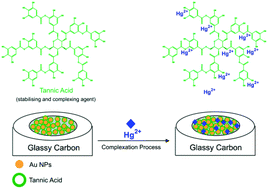
Analyst, 2018,143, 2035-2041
https://doi.org/10.1039/C8AN00508G
Fabrication of a self-assembled and flexible SERS nanosensor for explosive detection at parts-per-quadrillion levels from fingerprints
A self-assembled and flexible nanosensor was developed for ultrasensitive detection of explosives from latent fingerprints.
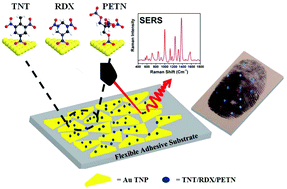
Analyst, 2018,143, 2012-2022
https://doi.org/10.1039/C8AN00008E
Carbon dots as analytical tools for sensing of thioredoxin reductase and screening of cancer cells
The addition of Cu2+ to a CD solution quenches the fluorescence emission of CDs while on the addition of TrxR, 2-mercaptopropanoic acid released from the surface of the CDs and emission from CDs was regained.
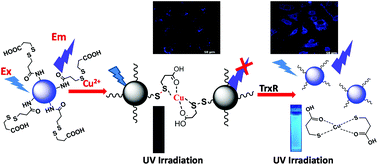
Analyst, 2018,143, 1853-1861
https://doi.org/10.1039/C7AN02040F
Surface enhanced Raman scattering sensor for highly sensitive and selective detection of ochratoxin A
An aptamer based SERS sensor was developed to detect picomolar concentrated ochratoxin solutions using an OPLS model.
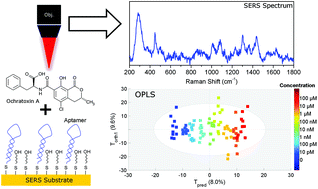
Analyst, 2018,143, 339-345
https://doi.org/10.1039/C7AN01730H
Combined determination of copper ions and β-amyloid peptide by a single ratiometric electrochemical biosensor
A novel ratiometric electrochemical biosensor was developed for the combined determination of copper ion and β-amyloid peptide.
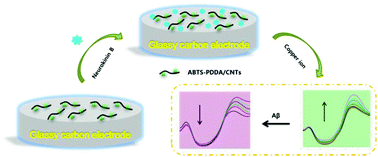
Analyst, 2018,143, 323-331
https://doi.org/10.1039/C7AN01683B
An ionic liquid-magnetic graphene composite for magnet dispersive solid-phase extraction of triazine herbicides in surface water followed by high performance liquid chromatography
A new ionic liquid-magnetic graphene composite was synthesized by a time-saving one-pot strategy for the extraction of triazine herbicides from surface water.

Analyst, 2018,143, 175-181
https://doi.org/10.1039/C7AN01290J
About this collection
A collection of recent reviews and research papers on the topics of analytical nanoscience published in Analyst curated by the Analyst Editorial Office
This topic is currently the focus of a themed collection in this field, led by Guest Editors Jun-Jie Zhu, Tim Albrecht, Russ Algar and Karen Faulds. More details about how to submit to the collection can be found at rsc.li/analytical-nanoscience-blog